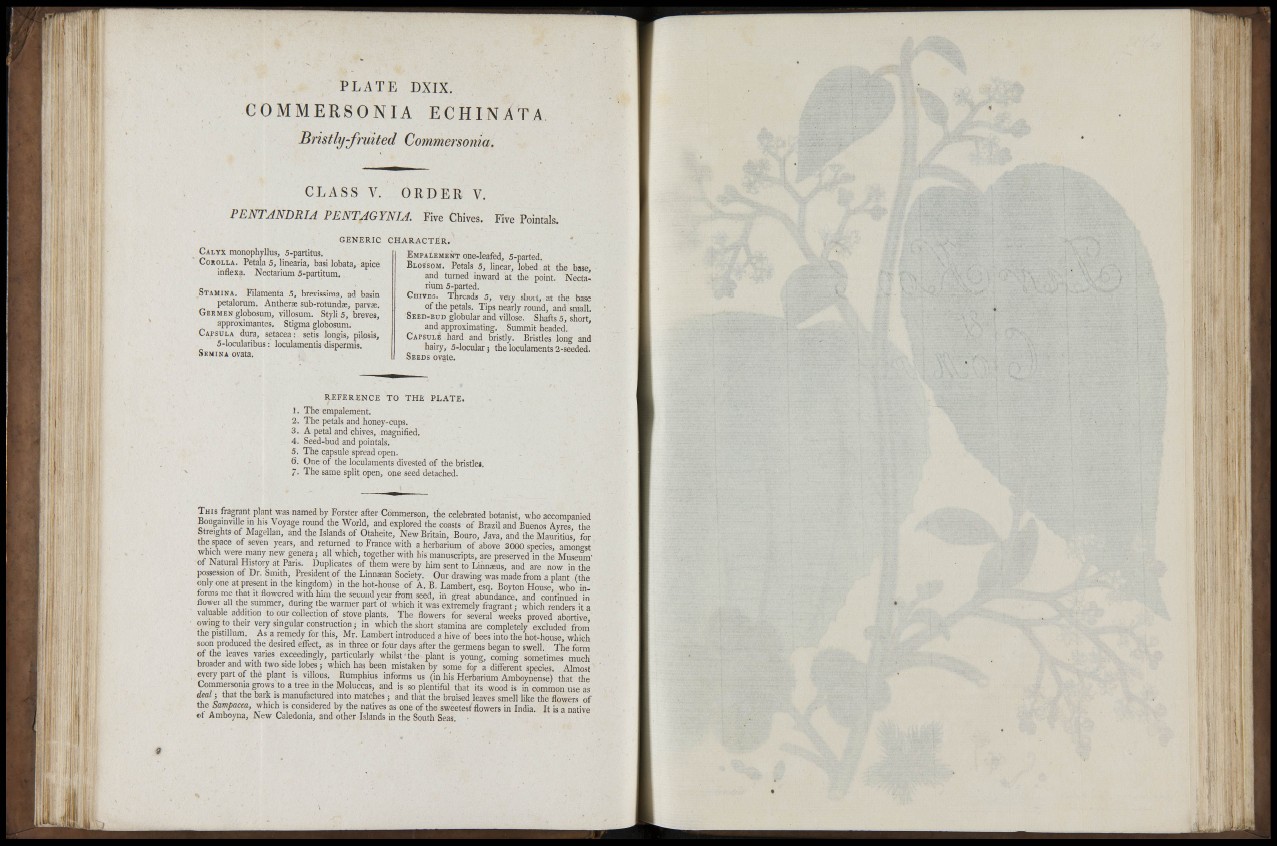
r»' :l
!1
P L A T E DXIX.
COMMERSONIA ECHINATA.
Bristly-fruited Commersonia.
CLASS V. ORDER V.
PENTANDRIA PENTAGYNIA. Five Chives. Five Pointais.
CALYX monophyUus^ 5-partitas.
COROLLA, Petak 5 , linearia^ basi lobata, apice
inflexa. Nectarium 5-partitutn.
STAMINA, Filaraenta 5, brevissima, ad basin
petalorum. Antherae sub-rotundas, parvae,
GEKMEN globosum, villosuin. Styli 5 , breves,
approximantes. Stigma globosum.
CAPSULA dura, setacea: setis longis, pilosis,
5-locularibus : loculamentis dispermis.
SEMINA ovata.
GENERIC CHARACTER.
EMPALEMENT one-leafed, 5-parted.
BLOSSOM. Petals 5, linear, lobed at the base,
and turned inward at the point. Nectarium
5-parted.
C H I V E S . Threads 5, very short, at the base
of the petals. Tips nearly round, and small.
S E E D - B U D globular and villose. Shafts 5, short,
and approximating. Summit headed.
CAPSULE hard and bristly. Bristles long and
hairy, 5-locular; the locularaents 2-seeded.
SEEDS ovale.
REFERENCE TO THE PLATE.
1. The empalement.
2. The petals and honey-cups.
3. A petal and chives, magnified.
4. Seed-bud and pointais.
5. The capsule spread open.
6. One of the loculaments divested of the bristle».
7- The same split open, one seed detached.
T H I S fragrant p ant was named by Forster after Commerson, the celebrated botanist, who accompanied
Bougamville m h.s Voyage rormd the World, and explored the coasts of Brazil and Buenos Ayres, the
Streights of Magellan, and the Islands of Otaheite, New Britain, Bouro, Java, and the Mauritius, for
the space of seven years, and returned to France with a herbarium of above 3000 species, amongst
wh^h were many new genera; all which, together with his manuscripts, are preserved in the Museum'
of Natural H^tory at Pans. Duplicates of them were by him sent to Linnaeus, and are now in the
possession of Dr. Smith, President of the Linnaean Society. Our drawing was made from a plant (the
only one at present m the kingdom) in tlie hot-house of A. B. Lambert, esq. Boyton House, who informs
me that it flowered with him the second year from seed, in great abundance, and continued in
flower all the summer, during the warmer part of which it was extremely fragrant; which renders it a
valuable addition to our collection of stove plants. The flowers for several weeks proved abortive
owing to their very singular construction j in which the short stamina are completely excluded from'
the pistillum. As a remedy for this, Mr. Lambert introduced a hive of bees into the hot-house, which
soon produced tne desired effect, as in three or four days after the germens began to swell The form
of the leaves varies exceedingly, particularly whilst the plant is young, coming sometimes much
broader and with two side lobes ; which has been mistaken by some for a different species. Almost
wery part of the plant is villous. Rumphius informs us (in his Herbarium Amboynense) that the
Coi^ersonia grows to a tree in the Moluccas, and is so plentiful that its wood is in common use as deal-, that the bark is manufactured into matches; and that the bruised leaves smell like the flowers of
the Sampacca, which is considered by the natives as one of the sweetest flowers in India. It is a native
ot Amboyna, New Caledonia, and other Islands in the South Seas.
- v i
¡.ill. '"M
: i II , '
V U !
i . i î »il !
li,. . î
i i i i :
(
t ' [•i
i ! . ; '